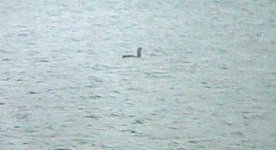-
Welcome to BirdForum, the internet's largest birding community with thousands of members from all over the world. The forums are dedicated to wild birds, birding, binoculars and equipment and all that goes with it.
Please register for an account to take part in the discussions in the forum, post your pictures in the gallery and more.
You are using an out of date browser. It may not display this or other websites correctly.
You should upgrade or use an alternative browser.
You should upgrade or use an alternative browser.
Any ideas? - Irvine Coast, Ayrshire, Scotland (1 Viewer)
- Thread starter CactusD
- Start date
- Status
- Not open for further replies.
More options
Who Replied?rokermartin
Well-known member
Looks like a Cormorant
maltese falcon
Well-known member
has the loch ness monster escaped from it's loch?
ta brandreth
Well-known member
Kelpie - juv/1st Winter....
The Hairy Highlander
Well-known member
RT Diver I reckon..
Marcus Conway - ebirder
Well-known member
Female Scaup
Phil Bishop
Well-known member
I reckon you can just see the throat markings of a black throated diver
I agree-enlarge the image sufficiently and you can see its a Black Throated.
The Kerreran
Has hat, will stand in the rain
Dave, is it looking to the right, or away from the camera?
Either way its still a Cormorant. Look at the even dark colour, the square pale area at the bill-base/cheek, the pale bill. Its neck looks thick because its swallowing a fish - you can see its become thinner again close under the head, no diver would show that. Finally, an adult Cormorant at this time of year has a very distinct white flank patch.
Either way its still a Cormorant. Look at the even dark colour, the square pale area at the bill-base/cheek, the pale bill. Its neck looks thick because its swallowing a fish - you can see its become thinner again close under the head, no diver would show that. Finally, an adult Cormorant at this time of year has a very distinct white flank patch.
AStevenson
Well-known member
Hard to say which diver but I get the impression of dark on the hindneck, and a rather pale throat from the slightly uptilted head, the former if not just shadow would suggest red-throat which is by far the commoner diver in Irvine Bay.
Cheers,
Andrew
Cheers,
Andrew
rokermartin
Well-known member
Cormorants can look thick necked at times.Ihave known them to be mistaken for divers on numerous occasions by birders.The bird in the pic appears to have the white face markings of a Cormorant.Also when they are swimming they lie low in the water like the bird in the pic.
Last edited:
CactusD
ἀρχός οἰω
I'm afraid I can't tell you which way it's looking, since it was one of those "quick, get nearest camera to hand" photography efforts. However, I did remember getting excited about it, which I don't think I would have with Cormorant. The sea was pretty calm.
Question: Shouldn't Cormorant have a sloping tapered back, not the short stubby one like this?
For the record, I wrote in my notebook Diver sp? Red-throated?, and then crossed out Red- and wrote Black- :eek!: :-O
I won't mind too much whatever it is since I've seen both these Diver species much more closely at hand before so no tick is riding on it. Pity!
Question: Shouldn't Cormorant have a sloping tapered back, not the short stubby one like this?
For the record, I wrote in my notebook Diver sp? Red-throated?, and then crossed out Red- and wrote Black- :eek!: :-O
I won't mind too much whatever it is since I've seen both these Diver species much more closely at hand before so no tick is riding on it. Pity!
Last edited:
The Kerreran
Has hat, will stand in the rain
I've had another long look, and can't combine diver with the blue-green glossy colour of this bird. Angle can be a tricky thing - it makes shapes change drastically - which was why I asked which way it was facing. An adult diver would have a darker throat than nape, an immature a white throat, both would stand out through the scope at that range [the phone reproducing much less than the eye would have seen].
Dave Appleton
Well-known member
I agree-enlarge the image sufficiently and you can see its a Black Throated.
I'm curious to know what extra detail you can see by enlarging the image. Personally I can't see it's a Black-throated whether I enlarge it or not. If it is a Diver then the unfortunate quality of the photo has masked it so well that it looks more like a Cormorant.
- Status
- Not open for further replies.
Users who are viewing this thread
Total: 2 (members: 0, guests: 2)




